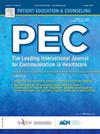Measures to evaluate clinician communication in the intensive care unit: A systematic review of measurement properties
IF 3.1
2区 医学
Q2 PUBLIC, ENVIRONMENTAL & OCCUPATIONAL HEALTH
引用次数: 0
Abstract
Objectives
Patients in the intensive care unit (ICU) face barriers to effective communication. Measures to evaluate communication quality remain limited. Patient and proxy reported outcome measures (PROMs and PrROMs) are increasingly being used to evaluate care in a patient-centered manner. We sought to identify validated PROMs and PrROMs for clinician communication quality in the ICU.
Methods
A systematic literature search was performed according to COSMIN guidelines. The search strategy included text words and subject headings related to communication (construct), ICU patients (population), and questionnaires or surveys (instrument). Studies were included if they focused on the development or measurement properties of a PROM or PrROM for clinician communication in the ICU, included adult patients or proxies, and were published in English after 2000. The results were imported to Covidence, a literature review citation screening tool and manager.
Results
10258 studies were identified. After removal of duplicates, 6210 titles and abstracts were screened for inclusion. 29 full texts were assessed. Six manuscripts assessing three measures, the Family Satisfaction in the ICU (FS-ICU), Critical Care Family Satisfaction Survey (CCFSS), and the Family Inpatient Communication Survey (FICS), met criteria for inclusion. The only measure to have undergone an adequate design process, per COSMIN criteria, was the FICS. The FS-ICU and CCFSS demonstrated sufficient content validity. The FS-ICU demonstrated indeterminate content validity, insufficient structural validity, and sufficient construct validity. The FICS demonstrated sufficient structural validity, internal consistency, and construct validity. Other measurement properties were not reported.
Conclusions
None of the identified measures met criteria for recommendation based on the COSMIN framework. Furthermore, none of the measures exclusively or comprehensively assessed communication quality.
Practice implications
Proxy measures evaluating the quality of clinician communication in the ICU are limited. New measures or significant revision of current measures is necessary alongside developing multidimensional protocols for assessment.
评估重症监护病房临床医生沟通的措施:对测量特性的系统回顾
目的探讨重症监护病房(ICU)患者有效沟通的障碍。评估通信质量的措施仍然有限。患者和代理报告的结果测量(PROMs和prrom)越来越多地被用于以患者为中心的方式评估护理。我们试图确定ICU临床医生沟通质量的有效prom和prrom。方法按照COSMIN指南进行系统的文献检索。搜索策略包括与沟通(结构)、ICU患者(人群)和问卷或调查(工具)相关的文本词和主题标题。如果研究集中在ICU临床医生交流的PROM或prorom的发展或测量特性,包括成人患者或代理人,并在2000年以后以英文发表,则纳入研究。将结果导入到文献综述引文筛选工具和管理器Covidence中。结果共纳入10258项研究。在删除重复后,6210篇标题和摘要被筛选纳入。评估了29个全文。6篇评估ICU家庭满意度(FS-ICU)、重症监护家庭满意度调查(CCFSS)和家庭住院患者沟通调查(FICS)三项指标的论文符合纳入标准。根据COSMIN的标准,唯一经过充分设计过程的措施是FICS。FS-ICU和CCFSS具有足够的内容效度。FS-ICU的内容效度不确定,结构效度不足,结构效度充足。FICS具有足够的结构效度、内部一致性和结构效度。其他测量特性未被报道。结论所确定的措施均不符合COSMIN框架的推荐标准。此外,没有一项措施专门或全面评估通信质量。实践意义评价ICU临床医生沟通质量的代理措施是有限的。在制定多维评估方案的同时,有必要采取新的措施或对现行措施进行重大修订。
本文章由计算机程序翻译,如有差异,请以英文原文为准。
求助全文
约1分钟内获得全文
求助全文
来源期刊

Patient Education and Counseling
医学-公共卫生、环境卫生与职业卫生
CiteScore
5.60
自引率
11.40%
发文量
384
审稿时长
46 days
期刊介绍:
Patient Education and Counseling is an interdisciplinary, international journal for patient education and health promotion researchers, managers and clinicians. The journal seeks to explore and elucidate the educational, counseling and communication models in health care. Its aim is to provide a forum for fundamental as well as applied research, and to promote the study of organizational issues involved with the delivery of patient education, counseling, health promotion services and training models in improving communication between providers and patients.
 求助内容:
求助内容: 应助结果提醒方式:
应助结果提醒方式:


